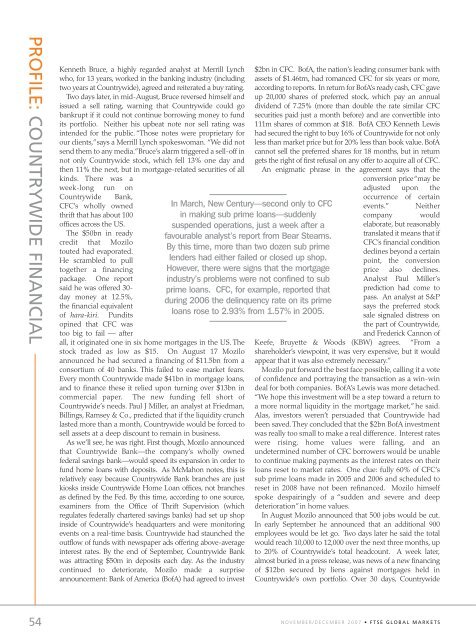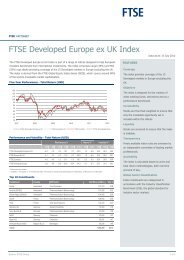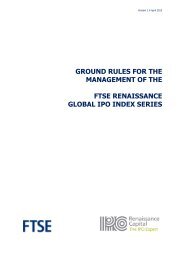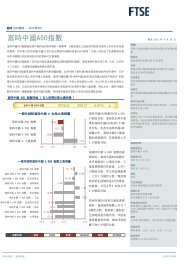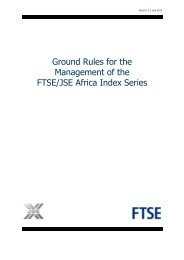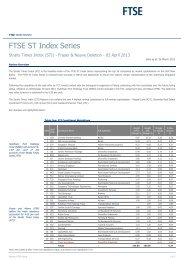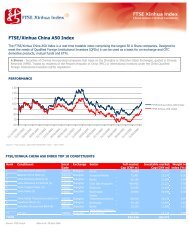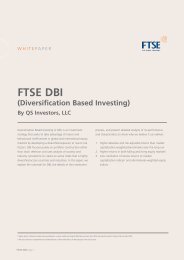Section 2 - FTSE
Section 2 - FTSE
Section 2 - FTSE
You also want an ePaper? Increase the reach of your titles
YUMPU automatically turns print PDFs into web optimized ePapers that Google loves.
PROFILE: COUNTRYWIDE FINANCIAL<br />
54<br />
Kenneth Bruce, a highly regarded analyst at Merrill Lynch<br />
who, for 13 years, worked in the banking industry (including<br />
two years at Countrywide), agreed and reiterated a buy rating.<br />
Two days later, in mid-August, Bruce reversed himself and<br />
issued a sell rating, warning that Countrywide could go<br />
bankrupt if it could not continue borrowing money to fund<br />
its portfolio. Neither his upbeat note nor sell rating was<br />
intended for the public. “Those notes were proprietary for<br />
our clients,”says a Merrill Lynch spokeswoman. “We did not<br />
send them to any media.”Bruce’s alarm triggered a sell-off in<br />
not only Countrywide stock, which fell 13% one day and<br />
then 11% the next, but in mortgage-related securities of all<br />
kinds. There was a<br />
week-long run on<br />
Countrywide Bank,<br />
CFC’s wholly owned<br />
thrift that has about 100<br />
offices across the US.<br />
The $50bn in ready<br />
credit that Mozilo<br />
touted had evaporated.<br />
He scrambled to pull<br />
together a financing<br />
package. One report<br />
said he was offered 30day<br />
money at 12.5%,<br />
the financial equivalent<br />
of hara-kiri. Pundits<br />
opined that CFC was<br />
too big to fail — after<br />
all, it originated one in six home mortgages in the US. The<br />
stock traded as low as $15. On August 17 Mozilo<br />
announced he had secured a financing of $11.5bn from a<br />
consortium of 40 banks. This failed to ease market fears.<br />
Every month Countrywide made $41bn in mortgage loans,<br />
and to finance these it relied upon turning over $13bn in<br />
commercial paper. The new funding fell short of<br />
Countrywide’s needs. Paul J Miller, an analyst at Friedman,<br />
Billings, Ramsey & Co., predicted that if the liquidity crunch<br />
lasted more than a month, Countrywide would be forced to<br />
sell assets at a deep discount to remain in business.<br />
As we’ll see, he was right. First though, Mozilo announced<br />
that Countrywide Bank—the company’s wholly owned<br />
federal savings bank—would speed its expansion in order to<br />
fund home loans with deposits. As McMahon notes, this is<br />
relatively easy because Countrywide Bank branches are just<br />
kiosks inside Countrywide Home Loan offices, not branches<br />
as defined by the Fed. By this time, according to one source,<br />
examiners from the Office of Thrift Supervision (which<br />
regulates federally chartered savings banks) had set up shop<br />
inside of Countrywide’s headquarters and were monitoring<br />
events on a real-time basis. Countrywide had staunched the<br />
outflow of funds with newspaper ads offering above-average<br />
interest rates. By the end of September, Countrywide Bank<br />
was attracting $50m in deposits each day. As the industry<br />
continued to deteriorate, Mozilo made a surprise<br />
announcement: Bank of America (BofA) had agreed to invest<br />
In March, New Century—second only to CFC<br />
in making sub prime loans—suddenly<br />
suspended operations, just a week after a<br />
favourable analyst’s report from Bear Stearns.<br />
By this time, more than two dozen sub prime<br />
lenders had either failed or closed up shop.<br />
However, there were signs that the mortgage<br />
industry’s problems were not confined to sub<br />
prime loans. CFC, for example, reported that<br />
during 2006 the delinquency rate on its prime<br />
loans rose to 2.93% from 1.57% in 2005.<br />
$2bn in CFC. BofA, the nation’s leading consumer bank with<br />
assets of $1.46trn, had romanced CFC for six years or more,<br />
according to reports. In return for BofA’s ready cash, CFC gave<br />
up 20,000 shares of preferred stock, which pay an annual<br />
dividend of 7.25% (more than double the rate similar CFC<br />
securities paid just a month before) and are convertible into<br />
111m shares of common at $18. BofA CEO Kenneth Lewis<br />
had secured the right to buy 16% of Countrywide for not only<br />
less than market price but for 20% less than book value. BofA<br />
cannot sell the preferred shares for 18 months, but in return<br />
gets the right of first refusal on any offer to acquire all of CFC.<br />
An enigmatic phrase in the agreement says that the<br />
conversion price “may be<br />
adjusted upon the<br />
occurrence of certain<br />
events.” Neither<br />
company would<br />
elaborate, but reasonably<br />
translated it means that if<br />
CFC’s financial condition<br />
declines beyond a certain<br />
point, the conversion<br />
price also declines.<br />
Analyst Paul Miller’s<br />
prediction had come to<br />
pass. An analyst at S&P<br />
says the preferred stock<br />
sale signaled distress on<br />
the part of Countrywide,<br />
and Frederick Cannon of<br />
Keefe, Bruyette & Woods (KBW) agrees. “From a<br />
shareholder’s viewpoint, it was very expensive, but it would<br />
appear that it was also extremely necessary.”<br />
Mozilo put forward the best face possible, calling it a vote<br />
of confidence and portraying the transaction as a win-win<br />
deal for both companies. BofA’s Lewis was more detached.<br />
“We hope this investment will be a step toward a return to<br />
a more normal liquidity in the mortgage market,”he said.<br />
Alas, investors weren’t persuaded that Countrywide had<br />
been saved.They concluded that the $2bn BofA investment<br />
was really too small to make a real difference. Interest rates<br />
were rising, home values were falling, and an<br />
undetermined number of CFC borrowers would be unable<br />
to continue making payments as the interest rates on their<br />
loans reset to market rates. One clue: fully 60% of CFC’s<br />
sub prime loans made in 2005 and 2006 and scheduled to<br />
reset in 2008 have not been refinanced. Mozilo himself<br />
spoke despairingly of a “sudden and severe and deep<br />
deterioration”in home values.<br />
In August Mozilo announced that 500 jobs would be cut.<br />
In early September he announced that an additional 900<br />
employees would be let go. Two days later he said the total<br />
would reach 10,000 to 12,000 over the next three months, up<br />
to 20% of Countrywide’s total headcount. A week later,<br />
almost buried in a press release, was news of a new financing<br />
of $12bn secured by liens against mortgages held in<br />
Countrywide’s own portfolio. Over 30 days, Countrywide<br />
NOVEMBER/DECEMBER 2007 • <strong>FTSE</strong> GLOBAL MARKETS


